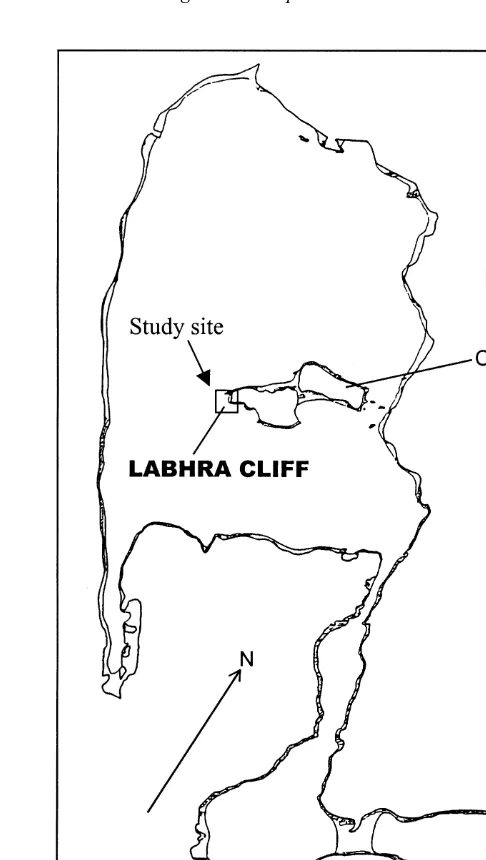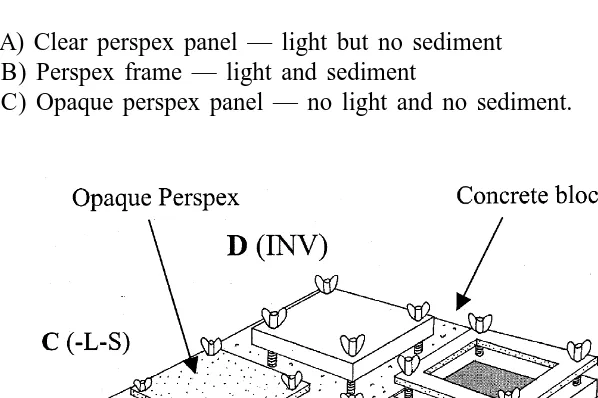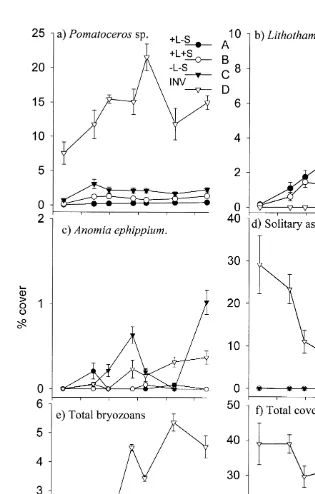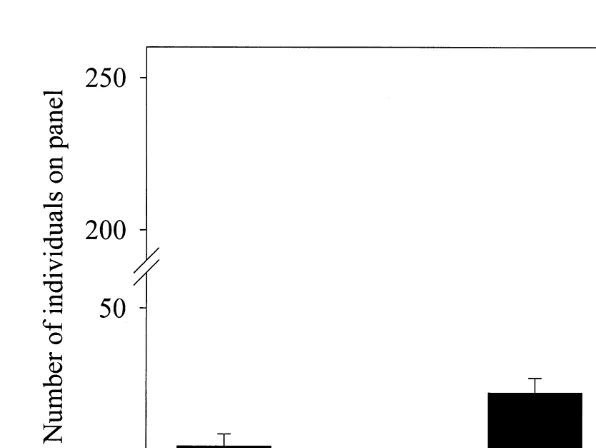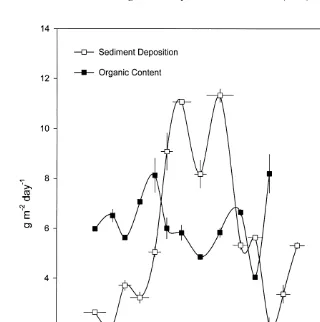256 (2001) 59–71
www.elsevier.nl / locate / jembe
The effects of sedimentation and light on recruitment and
development of a temperate, subtidal, epifaunal community
* Ben C. Maughan
Department of Zoology and Animal Ecology, Lee Maltings, University College Cork, Cork, Ireland
Received 13 June 2000; received in revised form 21 September 2000; accepted 2 October 2000
Abstract
Sedimentation has often been implicated as a factor in structuring epifaunal assemblages on hard substrata yet there are few studies that empirically test this relationship. This study investigated the effects of light and sedimentation conditions on the initial recruitment and subsequent development of an encrusting community at Lough Hyne, S.W. Ireland. Slate settlement panels were subjected to four different conditions of sedimentation and light. The five replicates of each treatment were photographed at approximately 6-week intervals over 13 months. Values for Brillouin diversity (HB) and number of recruits were greatest for shaded panels sheltered from sediment. Number of species was much higher on downward facing panels relative to upward facing panels, regardless of conditions of sedimentation and light. Sedimentation resulted in reduced cover for some species, such as Lithothamnion spp., whilst others, such as
Anomia ephippium, were less affected by this variable. Total space occupied was significantly
higher for inverted panels, possibly indicating geotaxic behaviour of some larvae. Number of species on each panel condition was more similar for sets of panels exposed for shorter periods relative to the 13-month experiment, implying that post-settlement mortality may differ between treatments. 2001 Elsevier Science B.V. All rights reserved.
Keywords: Epifauna; Light; Panels; Sedimentation
1. Introduction
Magnitude, or rate, of siltation has often been concluded to be a significant factor in determining species composition of subtidal communities encrusting hard substrata (e.g Maturo, 1959; Moore, 1977; Saiz-Salinas and Urdangarin, 1994). Rates of sediment
*Tel.: 1353-21-904-283.
E-mail address: [email protected] (B.C. Maughan).
deposition are often linked to environmental factors such as depth and flow speed (Hiscock, 1983; Overnell and Young, 1995). Sites with low degrees of water movement may be subject to high levels of siltation. Whilst siltation may be favourable to some organisms, e.g. deposit feeding holothurians, it is detrimental to many others and may
´
affect initial recruitment / choice of settlement site (e.g. Hiscock, 1983; Rodrıguez et al., 1993), and also post-settlement survival (Hunt and Shebling, 1997). Post-settlement processes include clogging of feeding apparatus (Eggleston, 1972), and, in extreme cases, depletion of dissolved oxygen (Hiscock, 1983). It is highly probable that reduced feeding efficiency owing to excess sediment may curb growth of some species. As growth rate is an important factor in determining competitive ability (Buss, 1986) this may mean that sedimentation may have important implications for outcomes of competitive interactions.
The negative phototaxis commonly exhibited in larvae of marine invertebrates (Young and Chia, 1985; Svane and Young, 1989) has confounded previous studies in this field, in that light and sediment load may be closely associated factors (e.g. Maturo, 1959; Nandakumar, 1995; Maldonado and Young, 1996). The present study separates this covariance by providing treatment panels where controls are applied for each variable. Many studies, mostly in coral reef communities, have identified specific mechanisms through which certain organisms may counteract increased sediment loads (Lasker, 1980; Logan, 1988; Stafford-Smith, 1993). Some previous investigations have looked at the effects of sedimentation at the community level over time (e.g. Umar et al., 1998), though very few have been in temperate environments (but see Airoldi, 1998). Community structures have also been compared between sedimented and relatively unsedimented habitats, such that siltation has been inferred as the reason for observed differences (e.g. Saiz-Salinas and Urdangarin, 1994). This approach, though, could be argued to have a degree of circular reasoning.
The present approach was novel in that bare slate panels were used as substrata and observed repeatedly on successive occasions. Panel surface conditions were manipulated to vary environmental sedimentation rates and exposure to light.
This study aims to address the following questions: (A) does the amount of sediment on substratum surface affect recruitment rates? and (B) do conditions of sedimentation affect the subsequent development of the encrusting community?
2. Methods
2.1. Study site
This study was done from February 1998 to October 1999 at the extremely sheltered sea lough of Lough Hyne, Co. Cork, S.W. Ireland (518309N, 98189W). A map of the site
2
showing the study area is given in Fig. 1. The lough is approximately 0.8 km and is connected to the sea via a narrow channel (named the Rapids). A sedimented plateau at 6 m below mean high water level (in the lough) on the West shore of the central Castle Island was chosen for this experiment. Below this plateau cliffs drop almost vertically to
21
Fig. 1. Map of Lough Hyne showing Labhra Cliff, the site used in this study.
and Marthasterias glacialis and several species of gobiid fishes (Wilkins and Myers, 1991).
Two related experiments using slate panels were carried out. The first looked at longer-term community development in relation to the factors described above, the second investigated seasonal recruitment on a shorter time scale, thus minimising impact of post-settlement mortality.
2.2. Community development
Five sets of four panels were assembled as in Fig. 2. The panels were of machined slate pieces approximately 15 mm thick and 15315 cm of the design of Todd and Turner (1986). Panels were prepared by drawing a blue square 10310 cm in the middle of each one with permanent marker pen to increase contrast, thus, facilitate identification of recruits (Todd and Turner, 1986). Plastic nuts and bolts and wing nuts were used to attach the perspex panels above the slate panels. The height of the nuts was adjusted to give 15 mm clearance between the perspex and the slate panel surface. The four panels within each block were designated A, B, C or D, and conformed to the following to give the environmental conditions on the slate panel surface as indicated:
(A) Clear perspex panel — light but no sediment (B) Perspex frame — light and sediment
(C) Opaque perspex panel — no light and no sediment.
(D) Panel had no perspex cover but was positioned upside down with the plastic bolts cut to leave a 15-mm gap between the panel surface and underlying substratum
Ten concrete blocks (44032103100 mm) were positioned in five pairs in a circular arrangement, each pair was approximately 2 m from the next. Four panels as above were positioned at random on each pair on 24th February 1998.
At approximately fortnightly intervals sediment was removed from the overlying perspex panels and all recruits to the perspex panels scraped off with a razorblade (as were recruits to the upper surface under the inverted (D) panels. This was done to maintain treatments as described and to prevent additional fouling of the experimental panels through growth and reproduction of these recruits. SCUBA was used to obtain photographic transparencies of all 20 panels at approximately six weekly intervals from June 1998 through to May 1999, using a Nikonos V with strobe, Fujichrome Sensia 100 ASA and close-up kit. Before photographing, each panel was held at arms length underwater and swung twice through 1808 to remove sediment which would have obscured underlying flora and fauna. Photographs were projected onto a grid of 400 dots and the percentage cover of different taxa was assessed by the number of points overlain (Meese and Tomich, 1992). The panels were removed on 28th April 1999 and all recruits counted and identified under binocular microscope.
2.3. Seasonal differences in recruitment
Three sets of the four panel conditions were positioned on two further occasions; a summer period (19th June to 28th July 1999) and an autumn period (4th September to 13th October 1999). All recruits were counted and identified at the end of the immersion period as above. Results for both sets could be directly compared, as the 39-day immersion period was identical.
2.4. Sedimentation rate
To quantify sedimentation rates, traps were deployed and retrieved at approximately monthly intervals from April 1998 through to August 1999 (mean deployment time61 S.E, 36.861.75 days). Plastic 250 ml measuring cylinders were used as the traps; these
˚ had an aspect ratio (width to height) of 1:9; well over the 1:3 recommended (Hakanson et al., 1989) to ensure no resuspension. A concrete block on the seabed with plastic clips bolted onto each corner was used to hold the traps. Four traps were deployed on each occasion, though it was not always possible to use all traps owing to dead invertebrates or fish getting stuck in them. Sediment was rinsed three times with fresh water and dried in an oven at 608C for 24 h to obtain dry weight. Samples were then heated in an oven at 4508C for 5 h to obtain the ash free dry weight.
2.5. Analysis of data
ANOVAs were carried out on number of species on the long-term panels and both sets of seasonal panels. Tukey tests were applied, a posteriori, where appropriate to assess differences between treatments. The Anderson–Darling test and Bartlett’s test were applied to each data set to verify the assumptions of normality and homogeneity of variance, respectively. Appropriate transformations (log10 and arc-sine) were applied where necessary (Winer et al., 1991; Zar, 1999). Percentage cover at the end of the experiment was compared using Kruskal–Wallis and an a posteriori Nemenyi test, as transformations failed to homogenise variances in this case. A paired sample t-test was used to compare percentage cover of Lithothamnion spp. on both types of sunlit (A and B) panels. As each panel was, effectively, a community and was completely censused at the termination of the experiment the Brillouin index was deemed the most appropriate measure of diversity (Pielou, 1975). The formula for this index is HB5(log10N!2
o log10n !) /N, where N is total number of species and n is number of individuals ofi i the ith species. As different values of this index are automatically significantly different from one another, tests for significant differences were unnecessary (Magurran, 1988).
3. Results
3.1. Differences between treatments
A total of 52 encrusting species were recorded during the course of this study. These included 24 bryozoans, five sponges, four hydroids, three polychaetes, six ascidians and a bivalve mollusc, Anomia ephippium. The treatment to which each panel was subjected had a highly significant effect on number of encrusting species present at the end of the 13-month experiment (Tables 1 and 2). A one-way ANOVA followed by Tukey tests demonstrated a clear hierarchy in terms of numbers of species (Table 2). The inverted (D) panels had the highest mean number of species (25.4), followed by the shaded, unsedimented (C) panels (12.0) then the unshaded, unsedimented (A) (6.8) and, finally, the unshaded, sedimented (B) panels (4.0). Treatments referred to as A, B, C or D from hereon. Similar analysis of the short term panels revealed the D summer panels to have a greater number of species than panels of the other three conditions (which were not significantly different) and that there was no detectable difference between treatments for the Autumn panels.
Total surface area occupied at the end of the long term experiment (see Fig. 3) varied
Table 1
Randomised block analysis of variance on number of encrusting species (log -transformed, Bartlett’s10 test53.41, P.0.05) on the long-term panels at the end of the experimental period
Source of variation df MS F P
No. of species
Treatment 3 0.5031 53.07 ,0.001
a
Location 4 0.0191 2.01 0.156
Error 12 0.0095
a
Table 2
a Mean number of species on panels from each of the four treatments for long-term, summer and autumn trials
Treatment Long-term Summer Autumn
Treatments abbreviated in parentheses, where L5light, S5sediment and INV5inverted. Standard errors follow means, number of replicates in parentheses.
significantly between treatments (Kruskal–Wallis H513.04, df53, P,0.01). Nemenyi tests revealed that the D panels had significantly greater cover than either C or B panels but, not the A panels ( q( 0.05 ), `, 453.48, critical value53.63), and that there was no significant difference between cover for A, B and C panels. Total cover (61 S.E) was 7.562.2% for the A panels and 27.663.4% for the D panels so it is, perhaps, surprising that the multiple comparisons found no significant difference. In terms of total numbers of individuals in each treatment, Tukey tests show that the A and C panels in the 13 month experiment did not significantly differ (Fig. 4). Both these treatments had less than the D panels and more than the B panels.
Brillouin diversity (HB) was highest (2.54) for D panels and lowest (0.68) for B panels. Of the two perspex-covered panels the value for HB was significantly higher for the C (dark) panels relative to the A (light) panels. (Table 3).
3.2. Response of individual species and species complexes
Response to panel treatment was not consistent across all taxa. The major space occupiers are shown in Fig. 3. It is clear that certain organisms such as the serpulid worm, Pomatoceros sp. occupied most space on the D panels followed by the C panels. Bryozoans clearly favoured the panels subjected to darker conditions; 11 and 22 species were found on the C and D panels, respectively, compared to four and one on the A and B panels, respectively. The cheilostome bryozoan, Aetea spp. was the only species found on all four treatments. Solitary ascidian species (including Ciona intestinalis, Ascidiella aspera, Molgula sp.) quickly came to dominate 30% of space on the D panels but showed a steady decline with time. No solitary ascidians were recorded on A, B or C panels. Anomia ephippium showed no preference for treatment. Coralline algae (Lithothamnion spp.) was a major space occupier on both panels subjected to light, more so on the A panels (paired t-test, t53.33, df534, P,0.01) which were sheltered from sedimentation (Fig. 3).
3.3. Sediment deposition
22 21
Fig. 4. Number of individuals on each panel treatment for long-term panels, n55 in each treatment, treatments abbreviated in parentheses as in Table 2. Standard error bars are given. Note the break in the y-axis.
22 21
around 12 g m day in the winter (Fig. 5). A notable drop in rate of sedimentation was evident in December, relative to the November and January samples. The organic content varied from around 15–30%.
4. Discussion
There were clear differences in terms of numbers of individuals, number of species and diversity for each panels condition on the long-term panels. Previous studies have established that the majority of encrusting species preferentially colonise either panel undersurfaces (Maturo, 1959) or overhangs (Moore, 1977; Saiz-Salinas and Urdangarin, 1994). It has been suggested that this preference may be owing to susceptibility to clogging by silt. A negative phototactic response of settling larvae may help to ensure that early juveniles would be sheltered from sedimentation (Maldonado and Young,
Table 3
a Diversity of panels from each treatment in the long-term experiment
Panel treatment Total Number of Species Brillouin diversity (HB)
A (1L2S) 9 1.25
B (1L1S) 7 0.68
C (2L2S) 23 1.61
D (INV) 42 2.54
a
Fig. 5. Variation in sediment deposition rate and organic content over the course of the experiment. Vertical standard error bars are shown. Horizontal error bars show the period of time over which that set of traps was deployed.
Both siltation and light have previously been implicated as important factors in structuring communities encrusting hard substrata (Young and Chia, 1984; Hurlbut, 1993). The present study provides some evidence for this. Encrusting coralline algae (Lithothamnion spp.) was present only on the A and B (sunlit) panels but the percentage cover was significantly higher on the A panels which were sheltered from siltation, this difference increasing with time. Similar results were obtained by Umar et al. (1998) who found that growth of the seaweed Sargassum was adversely affected by increased sedimentation.
Most species of bryozoan prefer sites of low deposition (Maturo, 1959; Moore, 1977). It has been stated that only lunulitiform colonies are able to tolerate siltation (Cook, 1963), though the present study found no such species on the sedimented panels. Aetea spp. was the only bryozoan found on the panels subjected to sediment (c.f. Maturo, 1959). The elongated erect zooids of this species may serve to maintain the polypide above the sediment layer on the panel surface thus avoiding clogging (Saiz-Salinas and Urdangarin, 1994).
Values for both Brillouin diversity (HB) and number of species were highest for the inverted D panels (sheltered from both light and sedimentation) and lowest for the B panels, which were subjected to both light and sedimentation. This agrees with the findings of Saiz-Salinas and Urdangarin (1994) who reported similar findings from a harbour in North-West Spain. As all panels sheltered from siltation scored much higher on this index than the B panels this could imply that shelter from siltation may be a more potent force in influencing encrusting community dynamics than shelter from light. Some previous panel studies have failed to make this separation, inferring that light is the sole factor responsible for differences in the community on upper and lower surfaces (e.g. Nandakumar, 1995).
Taxa present in high numbers on the D panels relative to the others, such as Ascidia mentula, didemnid ascidians, serpulids and various sponges, have been demonstrated to be good overgrowers of other species (e.g. Russ, 1982; Nandakumar, 1995). It is possible, then, that a few species dominating the assemblage on the D panels could impede the colonisation and subsequent growth of other species. The overall higher percentage cover on the D panels logically implies that competition for space was more intense.
The fact that the A and C panels had similar totals for individuals and that both had more than the B panels would seem to indicate that shelter from siltation may be more important than shelter from light for many species. Neither light nor siltation should account for differences in number of individuals between the C and the D panels as these treatments were assumed to be identical for factors other than panel orientation. A hypothesis that might be of interest here is the possibility that settlement on overhangs / undersurfaces may be affected by geotropic as well as phototropic responses of larvae (see Young, 1982). This hypothesis, however, cannot be tested using the present experimental design as the experiment was not strictly orthogonal; panel inversion is really a third factor and was used in place of a treatment which excluded light but permitted sedimentation. The inherent difficulties of producing a treatment with sediment but no light precluded inclusion of such a control.
22 21
studies. Overnell and Young (1995) recorded rates of around 12.5 g m day in Loch Linnhe in Scotland at a depth of 20 m, and concluded that sedimentation rate increased with depth. The peculiar trough in sediment deposition recorded in December (Fig. 3) coincided with a very calm period at sea with unusually high diving visibility (B. Maughan, personal observations). Only on 1 day during this deployment did the wave height exceed 3 m. In November, January and February waves regularly exceeded 3 m
´ and even 5 m on occasions (data from E. Murphy, Met Eireann).
A final consideration to be taken into account is that differences between panel treatments may actually have been underestimated, as new recruits are limited to those that are present in the species pool at the Cliff site studied. Previous work on settlement panels over a 2-year period has shown it to have a very distinct fauna compared to sites with higher water movement and lower sedimentation. Many species on cliffs at the study site tended to be those known to be more tolerant of siltation (Picton, 1991). This
´
may lead to spatial variation in larval availability (see Rodrıguez et al., 1993); larvae of species favouring less sedimented conditions may be uncommon relative to sites with more water movement.
Further work on this topic should concentrate on settlement events over much shorter time periods which will help to elucidate the relative contributions of choice of settlement site and post settlement mortality under the different experimental conditions. It must also be noted that the panel treatments may have affected predation on panel surfaces; a more complete experiment may utilise cages to control for this factor.
Acknowledgements
Thanks to all dive buddies who assisted during this project including Dave Barnes, Michelle Cronin, Amy Greenwood and James Bell. This work was carried out under a permit issued form Declan O’Donnell (Office of Public Works) and was funded by a postgraduate studentship from the Department of Zoology, UCC, Cork. [RW]
References
Airoldi, L., 1998. Role of disturbance, sediment stress, and substratum retention on spatial dominance in algal turf. Ecology 79, 2759–2770.
Buss, L.W., 1986. Competition and community organisation on hard surfaces in the sea. In: Diamond, J., Case, T.J. (Eds.), Community Ecology. Harper and Row, New York, pp. 517–536.
Cook, P.L., 1963. Observations of live lunulitiform zoaria. Cah. Biol. Mar. 4, 407–413.
Eggleston, D., 1972. Factors influencing the distribution of sub-littoral ectoprocts of the south of the Isle of Man (Irish Sea). J. Nat. Hist. 6, 247–260.
˚
Hakanson, L., Floderus, S., Wallin, M., 1989. Sediment trap assemblages — a methodological description. Hydrobiologia 176–177, 481–490.
Hiscock, K., 1983. Water movement. In: Earll, R., Erwin, D.G. (Eds.), Sublittoral Ecology: the Ecology of the Shallow Sublittoral Benthos. Clarendon Press, Oxford, pp. 58–96.
Hunt, H.L., Shebling, R.E., 1997. Role of post-settlement mortality in recruitment of benthic marine invertebrates. Mar. Ecol. Prog. Ser. 155, 269–301.
Kitching, J.A., Ebling, F.J., 1967. Ecological studies at Lough Hyne. Adv. Ecol. Res. 4, 198–292. Lasker, H.R., 1980. Sediment rejection by reef corals: The roles of behaviour and morphology in Montastrea
cavernosa (L.). J. Exp. Mar. Biol. Ecol. 44, 77–87.
Logan, A., 1988. Sediment shifting capability in the recent solitary coral Scolmyia cubensis (Milne-Edwards and Haime) from Bermuda. Bull. Mar. Sci. 42, 241–248.
Magurran, A.E., 1988. Ecological Diversity and Its Measurement. Croom Helm, London.
Maldonado, M., Young, C.M., 1996. Effects of physical factors on larval behaviour, settlement and recruitment of four tropical demosponges. Mar. Ecol. Prog. Ser. 138, 169–180.
Maturo, F.J.S., 1959. Seasonal distribution and settling rates of estuarine bryozoa. Ecology 40, 116–127. Maughan, B.C., Barnes, D.K.A., 2000. Seasonality of competition in developing subtidal communities. PSZN
Marine Ecology (in press).
Meese, R.J., Tomich, P.A., 1992. Dots on the rocks: a comparison of percent cover estimation methods. J. Exp. Mar. Biol. Ecol. 165, 59–73.
Moore, P.G., 1977. Inorganic particulate suspensions in the sea and their effects on marine animals. Oceanogr. Mar. Biol. Annu. Rev. 15, 225–363.
Nandakumar, K., 1995. Competitive interactions among sessile organisms in Tomioka Bay, south Japan: importance of light conditions on the panel surface. Mar. Biol. 121, 713–719.
Nandakumar, K., 1996. Importance of timing of panel exposure on the competitive outcome and succession of sessile organisms. Mar. Ecol. Prog. Ser. 94, 43–50.
Overnell, J., Young, S., 1995. Sedimentation and carbon flux in a Scottish sea lough, Loch Linnhe. Estuar. Coast. Shelf. Sci. 41, 361–376.
Pielou, E.C., 1975. Ecological Diversity. Wiley, New York.
Picton, B.E., 1991. The sessile fauna of sublittoral cliffs. In: Myers, A.A., Little, C., Costello, M.J., Partridge, J.C. (Eds.), The Ecology of Lough Hyne. Proceedings of a Conference 4–5 September 1990. Royal Irish Academy, Dublin, pp. 139–142.
´
Rodrıguez, S.R., Ojeda, F.P., Inestrosa, N.C., 1993. Settlement of benthic marine invertebrates. Mar. Ecol. Prog. Ser. 97, 193–207.
Russ, G.R., 1982. Overgrowth in a marine epifaunal community: competitive hierarchies and competitive networks. Oecologia 53, 12–19.
Saiz-Salinas, J.I., Urdangarin, I., 1994. Response of sublittoral hard substrate invertebrates to estuarine sedimentation in the outer harbour of Bilbao (N. Spain. Mar. Ecol. 15, 105–131.
Stafford-Smith, M.G., 1993. Sediment rejection efficiency of 22 species of Australian scleractinian corals. Mar. Biol. 115, 229–243.
Svane, I.B., Young, C.M., 1989. The ecology and behaviour of ascidian larvae. Oceanogr. Mar. Biol. Annu. Rev. 27, 45–90.
Todd, C.D., Turner, S.J., 1986. Ecology of intertidal and sublittoral cryptic epifaunal assemblages. I. Experimental rationale and the analysis of larval settlement. J. Exp. Mar. Biol. Ecol. 99, 199–231. Umar, M.J., McCook, L.J., Price, I.R., 1998. Effects of sediment deposition on the seaweed Sargassum on a
fringing coral reef. Coral Reefs 17, 169–177.
Wilkins, H.K.A., Myers, A.A., 1991. The distribution of gobies (Teleostei: Gobiidae). In: Myers, A.A., Little, C., Costello, M.J., Partridge, J.C. (Eds.), The Ecology of Lough Hyne. Proceedings of a Conference 4–5 September 1990. Royal Irish Academy, Dublin, pp. 107–115.
Winer, B.J., Brown, D.R., Michels, K.M., 1991. Statistical Procedures in Experimental Design, 3rd Edition. McGraw-Hill, New York.
Young, C.M., 1982. Larval behaviour, predation and early post-settlement mortality as determinants of spatial distribution in subtidal solitary ascidians of the San Juan Islands, Washington. PhD thesis, University of Alberta, 260 pp.
Young, C.M., Chia, F.S., 1984. Microhabitat-associated variability in survival and growth of subtidal solitary ascidians during the first 211 days after settlement. Mar. Biol. 81, 1–68.
Young, C.M., Chia, F.S., 1985. An experimental test of shadow response function in ascidian tadpoles. J. Exp. Mar. Biol. Ecol. 85, 165–175.
